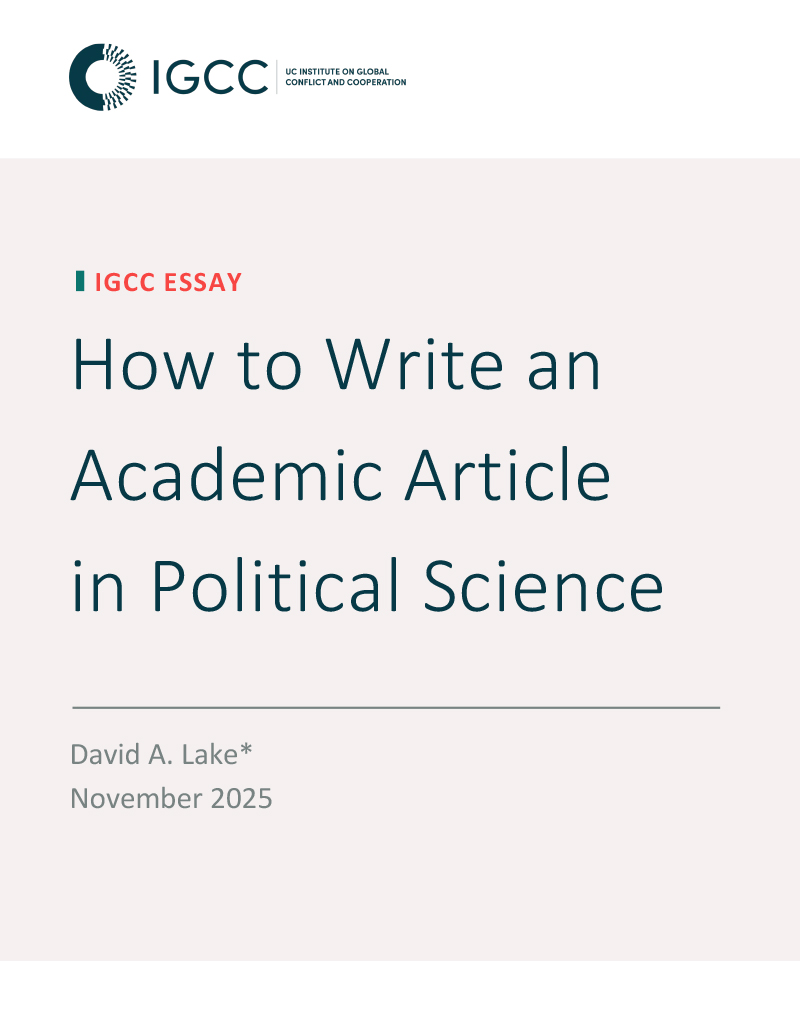How to Write an Academic Article in Political Science

While each paper may be unique, the process of writing an academic paper is not (or does not have to be). In the hopes of helping to make the process more efficient and the final product more clear, concise, and convincing, UC San Diego distinguished professor David Lake provides a formula with his best advice on how to prepare, structure, and publish an academic article in political science in this IGCC essay.
DownloadStep One: The Point
What is the point—your contribution? You are only allowed one. Save additional points for other papers.
- In an ideal world, you should be able to state your point in one sentence before you begin writing. This point then guides everything in the rest of your paper.
- For many of us, it takes time and multiple drafts of a paper to formulate the point crisply and clearly. In this case, once you can identify your point, you must rewrite the paper from front-to-back to ensure that each and every sentence contributes to the point. You must delete all “vestigial organs” that do not contribute to the point; though an idea or tangent might have been influential to you in identifying the point, this does not mean it should be in the paper. Once your point is clear, you must be ruthless in excising any extraneous material. This is why we write multiple drafts of most papers.
- In many cases, the point only becomes clear through public presentations. You literally see when listeners “get it.” Equally, you see where they don’t through confused faces and the questions that follow. A common problem is that you’ve thought so much about your paper that its clear to you but not to others who do not share your fascination. To succeed in most cases, you need to attract readers beyond the perhaps handful of specialists on your topic. Distilling your point so that it is clear to others takes practice and repetition.
Step Two: The Argument
- What is your argument or explanation? Your point in step one is your conclusion here. This is also a precisely formulated description of how you support your point developed in step one. On what basis do you claim to make your point?
- When in doubt, “draw it out”: flow charts, game trees (even if not solved), etc. are often helpful in clarifying your argument (but this does not mean they should be included in the paper).
Step Three: The Purpose
- If the goal of your paper is to develop a theory, then your purpose is to demonstrate the plausibility of your assumptions and the deductive validity of your argument. To demonstrate the plausibility of their assumptions, authors will often simply cite others who have made the same assumption (often in game theoretic proofs, for example). However, if you are going to be developing a new theory or refining an existing theory in a novel way, you may need to go beyond providing citations.
In theories, even though the premises are supposed to be true or plausible, often they are complex and novel. Indeed, many of the most important theories are based on novel assumptions which, after they are stated, become conventional wisdom. So, for the novel premises in your theory you need to provide evidence that your premises are plausible. While this is often done through citation, it may require extensive case studies or data analysis to demonstrate plausibility.
- If it is an empirical paper, your purpose can be (a) an exploration of your explanation, (b) a counterexample to someone else’s explanation, (c) a correlation derived from your explanation, or (d) a test of your explanation.
a. Exploration: Usually this involves case studies, though it may include a descriptive analysis of a larger set of data. Basically, exploration is a tour of your data, with your theory as a guide. There are no tests or correlations undertaken, at least not ones derived from your theory. The idea of an exploration is to demonstrate that your theory is plausible. Explorations may also be carried out to validate measures of variables draw from your theory (i.e., to demonstrate that your measure is a valid representation of your theoretical construct).
b. Counterexample(s): There is a theory (usually someone else’s) with an exactly specified prediction/hypothesis. You have a case study, experiment, or data analysis that involves an exact construct derived from the theory and a test of relationships given by the theory and you show the theory to be false. If so, you need to suggest, in the end, what might replace the false theory (you can’t replace something with nothing). Note well: do not transform the theory you are testing into a straw person because this only gives proponents of the original theory an opportunity to debunk your analysis. Be fair in stating the theory and your empirical critique.
c. Correlation: Your theory defines a comparative static—changes in x lead to changes in y. You can assess this prediction with many different statistical techniques, but it remains essentially a correlation. Assessing comparative static implications through correlation is still mostly what we do in political science. Here, you need to control for alternative explanations as well as you can, once again avoiding straw person analyses.
d. Test: you have either a randomized “true” experiment or a quasi-experiment. In either case, you need to defend your construct validity and your design. In causal tests you need to have at least two groups or both a pre- and post-test, otherwise you have a relational or correlational study. Specify both explicitly. . .
To read David’s full essay, download the PDF here.
Thumbnail image courtesy of Unsplash.